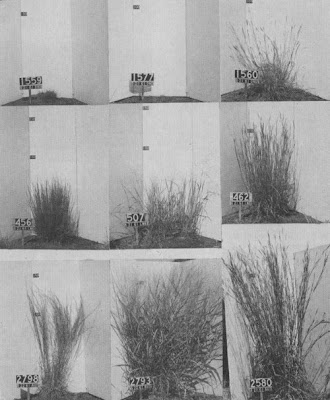
"The ways in which plants interact to form communities varies with the genetic constitution of the individual populations. In the prairies of the central united States, three species of grasses regularly grow together to form a community. These are Andropogon scoparius (left column), Panicum virgatum (center column), and Andropogon geradi (right column). All of the plants seen in these photographs were grown in Central Texas. The three strains at the top are from Devils Lake, North Dakota; the three in the center from Lincoln, Nebraska; and the three in the lower row from Austin, Texas. The most efficient use of energy input is shown by local ecotypes from central Texas, the least efficient by those from farthest away. Although these three grasses appear to form a repeatable community that has wide geographical extent, the way they adjust to the environment and to each other's presence obviously differs greatly from place to place. Each of the three strains of each species is genetically very different from all of the others. "
7/1/08
Biology of Plants
Subscribe to:
Post Comments (Atom)

No comments:
Post a Comment